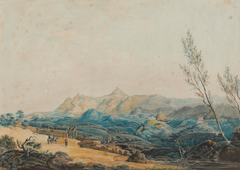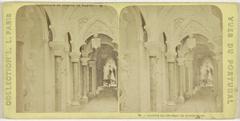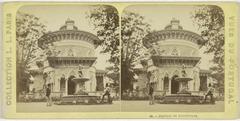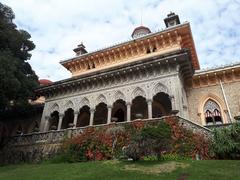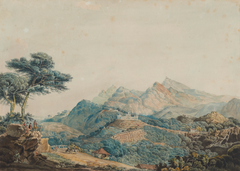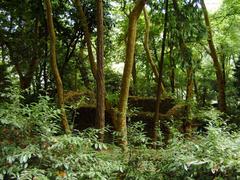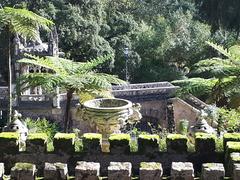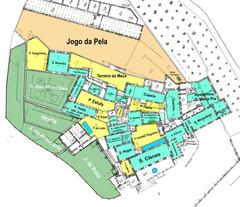
Visiting Parque de Monserrate: Hours, Tickets, and Tips
Published Date: 17/07/2024
Introduction to Parque de Monserrate
Parque de Monserrate, nestled in the enchanting hills of Sintra, Portugal, is a treasure trove of historical, architectural, and botanical wonders. With roots tracing back to the 16th century, this site has evolved into a celebrated landmark, encapsulating the essence of the Romantic movement. The park’s vibrant history began with a modest chapel built by Friar Gaspar Preto, which later gave way to a neo-Gothic mansion under Gerard de Visme in the 18th century. However, it was Sir Francis Cook’s acquisition in 1856 that truly transformed Monserrate into a masterpiece of Romantic architecture and landscape design. The palace, a blend of Gothic, Indian, and Moorish influences, along with the meticulously curated gardens featuring exotic species from around the globe, stand as testaments to this era’s artistic vision (Parques de Sintra, Visit Portugal). Today, Parque de Monserrate is not only a UNESCO World Heritage Site but also a vibrant cultural hub that attracts visitors worldwide. This guide aims to provide a comprehensive overview of what makes Parque de Monserrate an unmissable destination, including its historical significance, visitor information, travel tips, and more.
Contents Overview
- Exploring Parque de Monserrate - History, Visiting Hours, and Travel Tips
- History of Parque de Monserrate
- Early Beginnings
- The 18th Century - Gerard de Visme
- Sir Francis Cook and the Romantic Revival
- 20th Century Decline and Restoration
- UNESCO World Heritage Site
- Recent Developments
- Notable Features
- The Palace
- The Gardens
- The Chapel Ruins
- The Water Features
- Visitor Tips
- Visiting Hours
- Tickets
- Guided Tours
- Accessibility
- Photography
- Facilities
- FAQ
- Explore the Rich History and Beauty of Parque de Monserrate in Sintra - Visiting Hours, Tickets, and More
- Introduction
- Historical Significance
- Architectural Significance
- Botanical Significance
- Cultural Significance
- Visitor Information
- Visiting Hours
- Tickets
- Travel Tips
- Conservation and Restoration Efforts
- Educational and Research Significance
- Visitor Experience
- Economic Significance
- FAQ Section
- Conclusion
- Visitor Tips for Parque de Monserrate, Sintra - Best Times, Tickets, and More
- Introduction
- Best Time to Visit
- Getting There
- Entrance Fees and Opening Hours
- Guided Tours and Audio Guides
- Accessibility
- What to Wear and Bring
- Photography Tips
- Dining Options
- Nearby Attractions
- Safety Tips
- Environmental Responsibility
- Brief History and Cultural Significance
- FAQ
- Conclusion
Exploring Parque de Monserrate - History, Visiting Hours, and Travel Tips
History of Parque de Monserrate
Early Beginnings
The origins of Parque de Monserrate date back to the 16th century when a small chapel dedicated to Our Lady of Monserrate was built on the site. This chapel was constructed by Friar Gaspar Preto, a hermit who sought solitude in the Sintra hills. The chapel, however, fell into disrepair over the years, and by the 18th century, it was in ruins.
The 18th Century - Gerard de Visme
In 1789, Gerard de Visme, a wealthy English merchant, leased the property and constructed a neo-Gothic mansion on the ruins of the chapel. De Visme’s mansion was one of the first attempts to create a grand estate in the area, but it was not until the 19th century that Monserrate would gain its iconic status.
Sir Francis Cook and the Romantic Revival
The most significant chapter in the history of Parque de Monserrate began in 1856 when Sir Francis Cook, a British textile millionaire and art collector, purchased the estate. Cook was inspired by the Romantic movement, which emphasized the beauty of nature and the importance of creating harmonious landscapes. He commissioned the English architect James Knowles Jr. to design a new palace, blending Gothic, Indian, and Moorish influences.
The palace, completed in 1866, is a stunning example of Romantic architecture, featuring intricate stucco work, exotic motifs, and a central dome reminiscent of the Brighton Pavilion in England. The surrounding gardens were designed by the renowned landscape gardener William Stockdale, with assistance from botanist William Nevill and landscape painter François Deleuil. They transformed the estate into a lush, exotic paradise, introducing species from around the world, including Mexico, Japan, and Australia.
20th Century Decline and Restoration
After Sir Francis Cook’s death in 1901, the estate remained in the Cook family until the early 20th century. However, the property began to decline due to financial difficulties and the impact of World War I. By the mid-20th century, the palace and gardens were in a state of neglect.
In 1949, the Portuguese government acquired Parque de Monserrate, recognizing its historical and cultural significance. Restoration efforts began in the 1970s, focusing on preserving the architectural integrity of the palace and reviving the gardens. These efforts were further bolstered in the 21st century, with significant investments in conservation and tourism infrastructure.
UNESCO World Heritage Site
In 1995, Parque de Monserrate, along with the other palaces and gardens of Sintra, was designated a UNESCO World Heritage Site. This recognition highlighted the estate’s importance as a masterpiece of Romantic architecture and landscape design. The UNESCO designation has helped secure funding and international support for ongoing preservation efforts.
Recent Developments
In recent years, Parque de Monserrate has undergone extensive restoration to ensure its preservation for future generations. The palace’s intricate stucco work, stained glass windows, and exotic motifs have been meticulously restored, while the gardens have been rejuvenated with the reintroduction of rare plant species and the restoration of water features.
The estate now serves as a major tourist attraction, drawing visitors from around the world who come to marvel at its architectural beauty and lush gardens. The park also hosts cultural events, concerts, and exhibitions, further enhancing its status as a cultural and historical landmark.
Notable Features
- The Palace - The Monserrate Palace is a stunning example of Romantic architecture, blending Gothic, Indian, and Moorish influences. Its central dome, intricate stucco work, and exotic motifs make it a unique architectural gem.
- The Gardens - The gardens of Monserrate are a botanical wonderland, featuring species from around the world. Highlights include the Mexican Garden, the Japanese Garden, and the Rose Garden.
- The Chapel Ruins - The ruins of the original chapel built by Friar Gaspar Preto in the 16th century can still be seen on the estate, offering a glimpse into the site’s early history.
- The Water Features - The gardens are dotted with beautiful water features, including lakes, fountains, and cascades, which add to the serene and picturesque atmosphere.
Visitor Tips
- Visiting Hours - Parque de Monserrate is open daily, with extended hours during the summer months. It is advisable to check the official website for the most up-to-date information on opening times and ticket prices.
- Tickets - Tickets for Parque de Monserrate can be purchased online or on-site. Prices vary depending on the season and whether you choose to include guided tours.
- Guided Tours - To fully appreciate the history and significance of the estate, consider joining a guided tour. Knowledgeable guides provide insights into the architectural and botanical features of the park.
- Accessibility - The park has made efforts to improve accessibility, with paved paths and ramps for visitors with mobility issues. However, some areas of the gardens may still be challenging to navigate.
- Photography - Photography is allowed, and visitors are encouraged to capture the beauty of the palace and gardens. However, the use of tripods and drones is restricted.
- Facilities - The park offers a range of facilities, including a café, restrooms, and a gift shop. There are also picnic areas for visitors who wish to bring their own food.
FAQ
-
What are the visiting hours for Parque de Monserrate? Parque de Monserrate is open daily, with extended hours during the summer months. Check the official website for the most up-to-date information.
-
How much do Parque de Monserrate tickets cost? Ticket prices vary depending on the season and whether you choose to include guided tours. Visit the official website for detailed pricing.
-
Is Parque de Monserrate accessible for visitors with mobility issues? The park has paved paths and ramps, but some areas of the gardens may still be challenging to navigate.
For more detailed information, visit the official Parques de Sintra website.
By understanding the rich history of Parque de Monserrate, visitors can gain a deeper appreciation for this remarkable estate and its significance in the cultural and historical landscape of Sintra, Portugal.
Call to Action
For more updates, download the Audiala mobile app, check out other related posts, or follow us on social media.
Summary and Final Thoughts
Parque de Monserrate in Sintra, Portugal, encapsulates a rich tapestry of history, culture, and natural beauty, making it a must-visit destination for travelers. The estate’s transformation from a 16th-century chapel to a 19th-century Romantic masterpiece under the vision of Sir Francis Cook highlights its historical and architectural significance. The lush gardens, featuring exotic species and thematic landscapes, add to the park’s allure, offering visitors a serene and picturesque retreat. Extensive conservation efforts have ensured that Parque de Monserrate retains its charm and continues to educate and inspire future generations. Visitors are encouraged to explore not only the palace and gardens but also the wealth of cultural events and educational programs that the park offers. By visiting Parque de Monserrate, one contributes to the preservation of this historical gem and gains a deeper appreciation for the cultural heritage of Sintra (Europa Nostra, Sintra Parks). Whether you’re a history enthusiast, a nature lover, or simply looking for a beautiful place to visit, Parque de Monserrate promises an unforgettable experience.
Sources and Further Reading
- Exploring Parque de Monserrate - History, Visiting Hours, and Travel Tips, 2024 Parques de Sintra
- Explore the Rich History and Beauty of Parque de Monserrate in Sintra - Visiting Hours, Tickets, and More, 2024 Visit Portugal
- Visitor Tips for Parque de Monserrate, Sintra - Best Times, Tickets, and More, 2024 Europa Nostra
